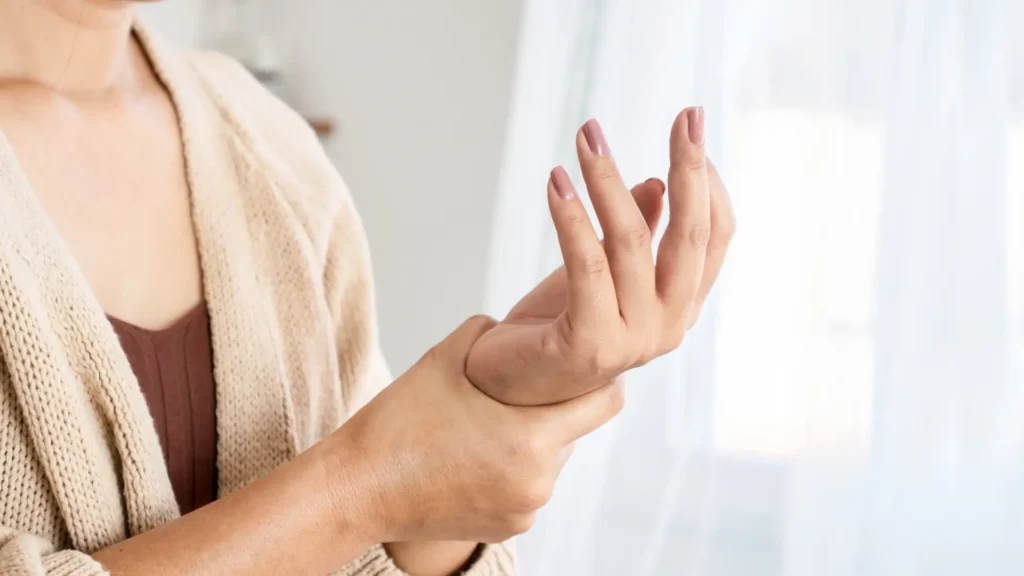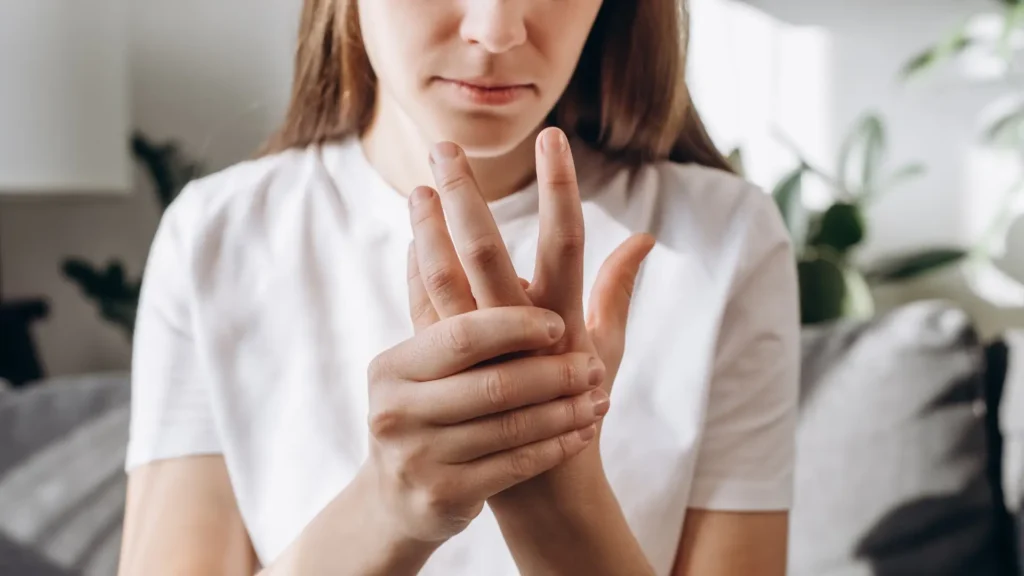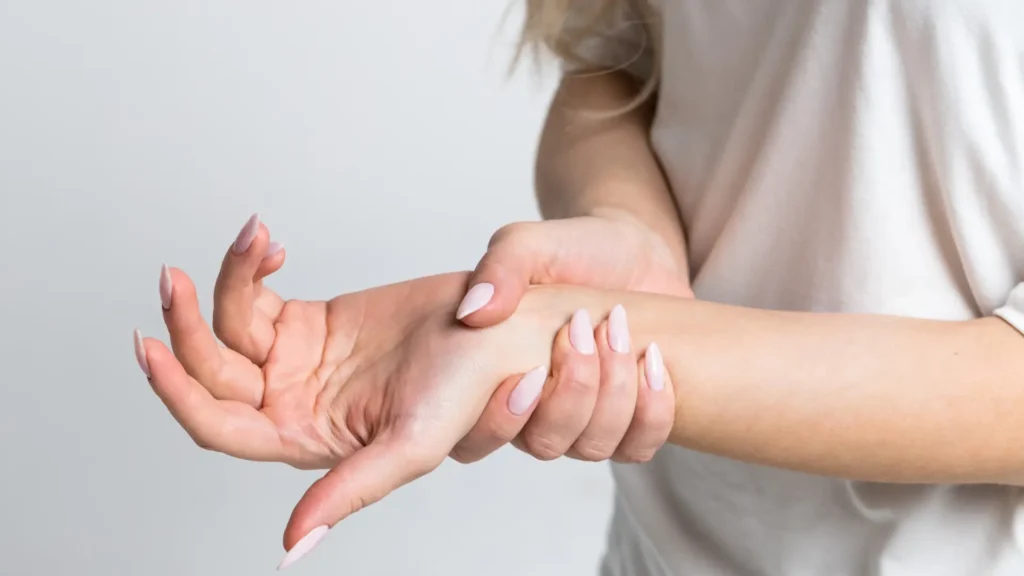This content is for informational purposes only and does not constitute medical advice. Please consult your local doctor or specialist for personalised guidance.
TL;DR – Postpartum Arthritis & Joint Pain
- Joint and back pain is fairly common during pregnancy and after delivery in Singapore, often due to physical load, posture changes, and carrying the baby.
- Most cases are muscular and mild.
- True arthritis flares (swollen, red, hot, tender joints) are uncommon and usually linked to pre-existing autoimmune conditions.
- Simple management works well: heat/cold packs, stretching, rest, good posture support (shoes, cushions), and paracetamol for pain.
- Seek medical help if joints are inflamed, pain persists despite simple measures, or there’s no prior autoimmune history but symptoms don’t improve.
- Most mothers tolerate mild pain themselves — consult your GP, family physician, or rheumatologist for persistent or concerning symptoms.
Have you ever felt like your body was working against you after bringing new life into the world? For many new mothers, the joy of holding their baby is overshadowed by unexpected aches and pains in their joints. If this sounds familiar, you may be experiencing postpartum arthritis.
But what exactly is postpartum arthritis, and why does it happen?
In this article, we’ll explore the causes, symptoms, and treatment options for this often overlooked condition that affects countless new mothers.
What Causes Postpartum Arthritis?

Postpartum arthritis can develop due to several factors related to pregnancy and childbirth. Understanding these causes can help new mothers recognize and manage their symptoms more effectively.
Hormonal Changes
During pregnancy, a woman’s body produces hormones that loosen joints and ligaments to prepare for childbirth. After delivery, these hormone levels begin to normalize, but the process can leave joints unstable for some time. This instability may lead to pain and discomfort as the body adjusts.
Immune System Over-activity
The immune system often becomes more active after pregnancy. This heightened activity can sometimes trigger autoimmune responses, leading to conditions like rheumatoid arthritis. In rare cases, the immune system may mistakenly attack healthy joint tissues, causing inflammation and pain.
Physical Stress
The physical demands of pregnancy and childbirth can put significant stress on a woman’s body. This stress may contribute to joint pain, particularly in the hips, lower back, and pelvis. The strain of carrying extra weight during pregnancy and the physical exertion of labor can both play a role in developing postpartum arthritis.
Pre-existing Conditions
Women with pre-existing arthritis or other autoimmune conditions may experience flare-ups after giving birth. About 46% of women with rheumatoid arthritis experience flares within 3 months of delivery. Pregnancy often suppresses symptoms of these conditions, but they may return or worsen in the postpartum period.
Weight Gain
The extra weight gained during pregnancy can put additional pressure on joints, especially in the lower body. This increased load may contribute to joint pain and arthritis symptoms after delivery, particularly if the extra weight is not lost quickly.
Genetic Factors
Some women may be genetically predisposed to developing arthritis. Pregnancy and childbirth can act as triggers for these individuals, causing the onset of arthritic symptoms in the postpartum period.
Understanding these causes can help new mothers and healthcare providers identify and address postpartum arthritis more effectively. If you experience persistent joint pain after giving birth, it’s important to consult with your healthcare provider for proper diagnosis and treatment.
What are the types of Postpartum Arthritis?

Postpartum arthritis can manifest in several forms, each with its own unique characteristics. Understanding these types can help new mothers and healthcare providers identify and address the condition more effectively.
Rheumatoid Arthritis
Rheumatoid arthritis is an autoimmune condition that can develop or flare up after pregnancy. In this type, the immune system mistakenly attacks healthy joint tissues, causing inflammation and pain. Some key features of postpartum rheumatoid arthritis include:
- Symmetrical joint pain, often affecting both sides of the body
- Stiffness in the morning that lasts more than 30 minutes
- Swelling and warmth in affected joints
- Fatigue and general feeling of being unwell
Women who had rheumatoid arthritis before pregnancy may experience a flare-up within 3 months after giving birth.
Osteoarthritis
While less common in younger women, osteoarthritis can develop or worsen after pregnancy due to the physical stress on joints. This type of arthritis is characterized by:
- Pain and stiffness in weight-bearing joints like hips and knees
- Reduced flexibility and range of motion
- Grating sensation when using the joint
- Bone spurs around the affected joint
The extra weight gained during pregnancy and the physical demands of caring for a newborn can exacerbate osteoarthritis symptoms.
Psoriatic Arthritis
Some women may develop or experience a flare of psoriatic arthritis after pregnancy. This type combines joint inflammation with the skin condition psoriasis. Symptoms include:
- Joint pain and stiffness, often in the fingers and toes
- Swollen fingers and toes
- Lower back pain
- Nail changes, such as pitting or separation from the nail bed
- Patches of red, scaly skin typical of psoriasis
Reactive Arthritis
In some cases, women may develop reactive arthritis after pregnancy. This type occurs as a reaction to an infection elsewhere in the body. Symptoms can include:
- Joint pain and swelling, typically in the knees, ankles, and feet
- Eye inflammation
- Urinary symptoms
- Skin rashes
Understanding these different types of postpartum arthritis can help new mothers recognize their symptoms and seek appropriate medical care. If you experience persistent joint pain after giving birth, it’s important to consult with your healthcare provider for proper diagnosis and treatment.
How common is Postpartum Arthritis in Singapore?
While there are no official figures for postpartum joint pains in Singapore, Dr. Leong notes that it is fairly common during pregnancy and postpartum, but most mothers tolerate it with simple measures like paracetamol and do not seek primary care solely for this.
“The common triggers are the physical load from pregnancy and carrying the infant, as well as posture changes — for example, adjusting position for nursing — which can affect muscles and joints,” Dr. Leong explains. “Very uncommonly, a small group with autoimmune conditions may experience flare-ups during this period.”
What are the Symptoms of Postpartum Arthritis?

Recognizing the symptoms of postpartum arthritis and getting a proper diagnosis are crucial steps in managing this condition effectively. Let’s explore the common signs and the diagnostic process.
Common Symptoms
Postpartum arthritis can manifest in various ways, but some typical symptoms include:
- Joint pain, especially in the hips, knees, and fingers
- Stiffness, particularly in the morning or after periods of inactivity
- Swelling in affected joints
- Reduced range of motion
- Fatigue
- Weakness in the hands (if carpal tunnel syndrome is present)
- Lower back pain that may radiate to the legs
How is Postpartum Arthritis Diagnosed?
If you’re experiencing persistent joint pain after giving birth, your healthcare provider may use several methods to diagnose postpartum arthritis:
- Physical Examination: Your doctor will check for swelling, redness, and warmth in your joints. They may also assess your range of motion and overall physical condition.
- Medical History: You’ll be asked about your symptoms, when they started, and any factors that make them better or worse.
- Blood Tests: These can help identify inflammation markers and rule out other conditions.
- Imaging Tests: X-rays, ultrasounds, or MRI scans may be used to get a detailed look at your joints and surrounding tissues.
- Joint Fluid Analysis: In some cases, a small sample of fluid from the affected joint may be extracted and analyzed for signs of infection or inflammation.
Differential Diagnosis
Postpartum joint pain can be caused by various conditions, not just arthritis. Your healthcare provider will consider other potential causes, such as:
- Pelvic girdle pain (PGP)
- Carpal tunnel syndrome
- Piriformis syndrome
- Hyperthyroidism
- Normal postpartum recovery pain
What are the Postpartum Arthritis Risk Factors?
Several factors can increase a woman’s likelihood of developing postpartum arthritis. Understanding these risk factors can help new mothers and healthcare providers be more vigilant and proactive in managing joint health after childbirth.
Pre-existing Conditions
Women with a history of arthritis or autoimmune disorders are at higher risk of experiencing postpartum arthritis. This includes conditions such as:
- Rheumatoid arthritis
- Psoriatic arthritis
- Systemic lupus erythematosus (SLE)
For these women, pregnancy may have temporarily suppressed their symptoms, but the postpartum period often brings a resurgence of disease activity.
Active Disease During Pregnancy
Research shows that women who had active arthritis during pregnancy, especially in the second and third trimesters, are more likely to experience postpartum flares. This underscores the importance of maintaining good disease control throughout pregnancy.
Medication Changes
Discontinuing certain medications, particularly anti-tumor necrosis factor-α (TNFα) drugs, early in pregnancy or immediately after childbirth can increase the risk of postpartum flares. It’s crucial for women to work closely with their rheumatologists to manage medication transitions safely.
Age and Weight
Older mothers (over 40) and those who gained significant weight during pregnancy may be at higher risk for postpartum joint pain, especially in weight-bearing joints like the knees and hips.
Hormonal Factors
The rapid changes in hormone levels after childbirth can trigger joint inflammation in some women. The hormone relaxin, which helps loosen joints for childbirth, can persist in the body for up to six weeks postpartum, potentially contributing to joint instability and pain.
Regarding hormonal causes, Dr. Leong explains: “Most often the mother’s body will self-regulate and adjust itself — just give it time.” For confinement support, he stresses the importance of practical help: “The most important part is really the help in household chores, cooking for themselves, and looking after the infant. In this respect, the fathers can play a strong role.”
Genetic Predisposition
Women with a family history of arthritis or autoimmune disorders may be more susceptible to developing postpartum arthritis.
Physical Stress
The physical demands of pregnancy, labor, and caring for a newborn can put significant stress on a woman’s joints, potentially triggering or exacerbating arthritic symptoms.
How long does Postpartum Arthritis last?

Postpartum arthritis is not typically a permanent condition for most women. Many new mothers experience joint pain and inflammation after giving birth, but these symptoms often subside within a few months. The duration and severity of postpartum arthritis can vary greatly from person to person.
For many women, postpartum arthritis is a temporary condition that resolves as their bodies recover from pregnancy and childbirth. Hormonal changes, physical stress, and immune system fluctuations during this period can contribute to joint pain, but these factors usually stabilize over time.
Some women may experience longer-lasting symptoms, especially if they had pre-existing arthritis or autoimmune conditions before pregnancy. In these cases, postpartum arthritis might evolve into a chronic or recurring issue that requires ongoing management.
Dr. Leong notes that: “Most back and joint pain among postpartum mothers is muscular and resolves with simple measures. Those with autoimmune conditions will have joint swelling — the joints are usually swollen, red, hot, and tender.”
Early intervention and proper care are crucial in preventing postpartum arthritis from becoming a long-term problem. Treatment options may include:
- Medications to manage pain and inflammation
- Physical therapy to improve joint function
- Weight management to reduce stress on joints
- Lifestyle modifications to support overall joint health
While postpartum arthritis is generally not considered permanent, it’s essential for new mothers to work closely with their healthcare providers to monitor symptoms and develop an appropriate treatment plan. With proper care and management, most women can expect their joint health to improve over time.
How is Postpartum Arthritis Treated?

Managing postpartum arthritis involves a combination of medical interventions and lifestyle changes. The goal is to reduce pain, improve joint function, and enhance overall quality of life for new mothers.
Medications
Several medications can help manage postpartum arthritis symptoms:
- Over-the-counter pain relievers: Acetaminophen (Tylenol) and nonsteroidal anti-inflammatory drugs (NSAIDs) like ibuprofen can help reduce pain and inflammation.
- Prescription medications: For more severe cases, doctors may prescribe stronger pain relievers or disease-modifying antirheumatic drugs (DMARDs) to slow the progression of arthritis.
- Topical treatments: Pain-relieving creams or medicated patches applied directly to painful areas can provide localized relief.
Dr. Leong advises that most mild pain can be managed with paracetamol and rest does not require a doctor visit. However, seek medical help if:
- Joints are inflamed (swollen, red, hot, tender)
- Pain persists despite simple measures
- You have no prior autoimmune history but symptoms do not improve
In these cases, consult your GP/family physician or rheumatologist.
Non-pharmacological Approaches
Several non-drug treatments can be effective in managing postpartum arthritis:
- Physical therapy: A physical therapist can teach exercises to strengthen muscles around affected joints and improve flexibility.
- Heat and cold therapy: Applying heat or cold to painful joints can help reduce pain and stiffness. Heat therapy is often more effective for chronic pain, while cold therapy works well for acute pain and swelling.
- Supportive devices: Using pillows during breastfeeding or a nursing pillow can help support your arms and back, reducing strain on your joints.
Lifestyle Modifications
Making certain lifestyle changes can significantly improve postpartum arthritis symptoms:
- Exercise: Light to moderate exercise, such as walking or swimming, can help strengthen muscles and improve joint flexibility.
- Diet: Consuming a balanced diet rich in fruits and vegetables may help manage arthritis symptoms. Some women find relief by avoiding inflammatory foods like processed meats, alcohol, and caffeine.
- Weight management: Maintaining a healthy weight can reduce stress on weight-bearing joints like hips and knees.
- Rest and pacing: Balancing activity with rest periods can help manage fatigue and prevent overexertion of painful joints.
- Proper posture: Being mindful of your posture, especially during activities like breastfeeding or carrying your baby, can help reduce joint strain.
For relief, Dr. Leong recommends: “Simple measures like heat treatment, cold compress, stretching, ergonomic support (good shoes, cushions, guards), and common medications like paracetamol work very well for most cases.”
How does Postpartum Arthritis affect Breastfeeding?

Postpartum arthritis can affect breastfeeding, but it doesn’t necessarily prevent it. Many women with rheumatic diseases can and are encouraged to breastfeed their babies. Breastfeeding offers numerous benefits for both mother and child, including potential protection against future rheumatoid arthritis for the baby.
The main challenges arise from joint pain and stiffness, which can make holding the baby uncomfortable. Mothers may need to adjust their breastfeeding positions using pillows or other supports to reduce strain on painful joints. Some arthritis medications can be passed through breast milk, so it’s crucial to consult with a doctor about safe options while breastfeeding.
Dr. Leong notes that for autoimmune-related joint pain requiring anti-inflammatory medication, nursing may need to be paused temporarily: “These medicines usually need to be prescribed, and not infrequently the physician will advise against nursing the baby when taking these anti-inflammatory medicines.”
Prioritize Your Joint Health

Postpartum arthritis can be challenging, but with proper care and attention, many new mothers can manage their symptoms effectively. It’s crucial to know when to seek medical help. Contact your healthcare provider if you experience:
- Severe joint pain that interferes with daily activities or childcare
- Persistent swelling or redness in your joints
- Fever along with joint pain
- Sudden inability to move a joint
FAQ – Postpartum Arthritis & Joint Pain
1) Is Postpartum Arthritis & joint pain common in Singapore?
Joint and back pain is fairly common during pregnancy and after delivery, often due to physical load and posture changes. However, true arthritis flares are uncommon.
2) What causes joint pain after giving birth?
Most cases are muscular — caused by carrying the baby, posture adjustments (e.g., for nursing), and the physical load of pregnancy. Rarely, autoimmune conditions can flare up postpartum.
3) How can I tell if it’s normal muscle pain or actual arthritis?
Muscular pain usually resolves with rest and simple measures. Arthritis-related pain involves swollen, red, hot, and tender joints — see a doctor if you notice these signs.
4) When should I see a doctor for postpartum joint pain?
Seek help if joints are inflamed (swollen, red, hot, tender), pain persists despite simple measures, or symptoms don’t improve even without a prior autoimmune history. Your GP, family physician, or rheumatologist can assess.
5) What safe home relief options are there for mild postpartum joint pain?
Heat or cold packs, stretching, good posture support (ergonomic shoes, cushions, guards), rest, and paracetamol often work well. Avoid self-medicating with stronger drugs without advice.
6) Are anti-inflammatory medicines safe while breastfeeding?
Some require a prescription, and doctors may advise against breastfeeding while taking them — always check with your physician first.
7) Can hormonal changes cause postpartum joint pain?
Hormonal shifts play a role, but most mothers’ bodies self-regulate and adjust over time. Give it time and focus on supportive measures.
8) How does confinement diet or practices affect postpartum joint pain?
The most important support is help with household chores, cooking, and infant care. Fathers can play a strong role here — practical assistance reduces physical strain.
9) Is it normal to self-medicate with paracetamol for postpartum joint pain?
Yes, most mothers tolerate mild pain with paracetamol and do not seek primary care solely for this — but consult a doctor if it persists or worsens.
10) Should I be concerned if joint pain appears suddenly after delivery?
Sudden or severe pain, especially with swelling or redness, should be checked. For mild muscular aches, simple measures are usually sufficient.
About the Expert

Dr Leong Choon Kit
MBBS, M.Med (Public Health), GDFM, MCFP(S), FCFP(S), FAMS(Family Medicine)
Dr. Leong Choon Kit is one of the Doctors at MMC. A dedicated physician with a background in Public Health and Family Medicine, focusing on public policy, social issues, and vaccination advocacy.




